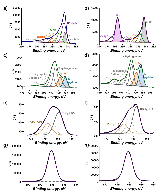Role of Surface Chemistry on Catalyst/Ionomer Interactions for Transition Metal–Nitrogen–Carbon Electrocatalysts
- Univ. of New Mexico, Albuquerque, NM (United States)
- Univ. of New Mexico, Albuquerque, NM (United States); Los Alamos National Lab. (LANL), Los Alamos, NM (United States)
- Colorado School of Mines, Golden, CO (United States)
The role of the interaction between doped carbon-based materials and ionic conductors is essential in multiple technologies, from fuel cells and energy storage devices to conductive polymer composites. In this paper, we report how the surface chemistry of transition metal–nitrogen–carbon (MNC) electrocatalysts affects catalyst–ionomer interaction and the resulting structure of cathodes. The cathode structure resulting from these interactions is directly related to the performance in membrane electrode assembly (MEA) fuel cells. To advance the development of platinum group metal (PGM)-free electrodes for the oxygen reduction reaction it is necessary to understand the structure of the catalyst layers with focus on chemistry and distribution of active sites and ionomer morphology. To assess catalyst interaction with an ionomer, X-ray photoelectron spectroscopy is applied to study the chemistry of catalyst layers while density functional theory (DFT) is used to calculate adsorption energies of the ionomer side chain on different nitrogen species. We report that a high surface concentration of hydrogenated nitrogen at the surface of MNC catalysts causes inefficient ionomer morphology, while an abundance of surface oxides promotes both an efficient distribution of active sites and an optimal ionomer–catalyst interface. The critical role of protonation of nitrogen within catalytic layers in inhibiting proton transport during fuel cell operation is also suggested. As a result, this is the first report of the effect the surface chemistry of MNC catalysts, in the presence of the ionomer, has on the structure and performance of MEA electrodes.
- Research Organization:
- Los Alamos National Lab. (LANL), Los Alamos, NM (United States)
- Sponsoring Organization:
- National Science Foundation (NSF); USDOE
- Grant/Contract Number:
- AC52-06NA25396
- OSTI ID:
- 1418766
- Report Number(s):
- LA-UR-17-24807
- Journal Information:
- ACS Applied Energy Materials, Vol. 1, Issue 1; ISSN 2574-0962
- Publisher:
- American Chemical Society (ACS)Copyright Statement
- Country of Publication:
- United States
- Language:
- English
Web of Science
Ionomer distribution control in porous carbon-supported catalyst layers for high-power and low Pt-loaded proton exchange membrane fuel cells
|
journal | September 2019 |
Chemically soft solid electrolyte interphase forming additives for lithium-ion batteries
|
journal | January 2018 |
Similar Records
Atomically dispersed metal–nitrogen–carbon catalysts for fuel cells: advances in catalyst design, electrode performance, and durability improvement
Elucidating the Role of Ionomer in the Performance of Platinum Group Metal-free Catalyst Layer via in situ Electrochemical Diagnostics









